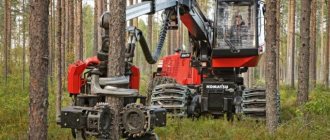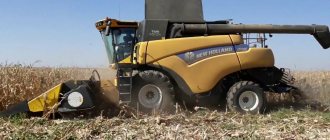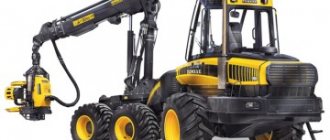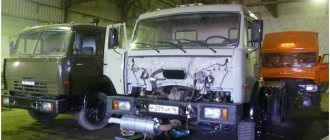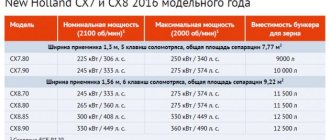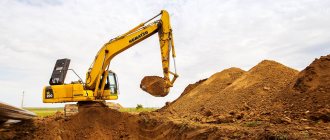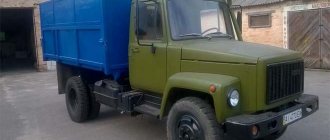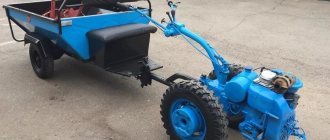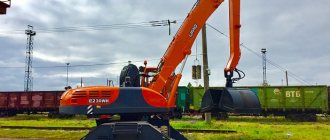Choosing the ideal harvester-forwarder pair is a task that foresters approach with great responsibility, because correctly selected machines are the key to successful and most efficient work on the plot. The mechanized logging system, which is popular in the Scandinavian countries, in which multi-purpose forestry machines are used, is being actively implemented not only in Russia, but also in the CIS countries.
Interesting: before the market of special equipment was flooded with harvesters and forwarders of famous brands in abundance, specialists from the Karelian Research Institute of Forestry Industry in 1984 developed the first set of machines in the Soviet Union for harvesting logs, and it was successfully used in the country’s logging sites for quite a long time.
We talked about how to choose a forwarder for a specific task in the last article, but now let’s turn our attention to its multifunctional brother, which many forest fellers respectfully call a “forest harvester.”
Since the harvester is designed to perform several tasks at once, including felling trees, removing branches, bucking, etc., when choosing a machine you need to pay attention to such important criteria as engine power, productivity and, of course, ability equipment to work on complex plots and various soils.
You should not make a choice, as they say, “at random”: first you need to assess the conditions in which you will operate the machine. If logging sites are located at a decent distance from each other, then a wheeled harvester will be the optimal solution. Tracked analogues are best used in flat areas. At the same time, the performance of wheeled and tracked machines has practically no differences; some manufacturers also provide the opportunity to supplement the wheeled harvester model with tracks.
Important selection criteria are also the availability of comfortable conditions for the operator, cabin equipment and, not surprisingly, the cost of a particular machine.
Below we will look at several models of harvesters from the most popular manufacturers on the forestry equipment market, including such well-known brands as Ponsse, John Deere, Komatsu...
John Deere 803MH harvester: high productivity in difficult conditions
The John Deere 803MH is a tracked harvester that, according to the manufacturer, can operate effectively even in the harshest conditions, which is important for logging, for example, in Siberia. The machine is equipped with a fuel tank increased by 50%, thanks to which it can operate for up to 24 hours without refueling.
Photo: https://www.deere.ru
The stability of the harvester is ensured by a long and wide chassis, as well as two turning motors with increased torque (they are provided as standard), which allow the machine to be operated on slopes with large stands of trees.
The operator can control boom movement with a single joystick thanks to the boom's Rapid Raise and Lower System (RCS). It can also be adjusted depending on the operator’s level of training and the specific conditions on the forest site. In this case, it is possible to save individual system settings.
As for equipment maintenance, the manufacturer claims that convenient access is provided to all machine components, and therefore maintenance and scheduled maintenance do not require much time. The built-in hydraulic fan with reverse function automatically changes the direction of air flow, cleaning the radiators from dust and dirt.
Engine power : 224 kW (305 hp)
Boom radius : 8.84 m
Traction force : 245 kN
Harvester heads : HTH616C, HTH622B and HTH623C
John Deere 1470G wheeled harvester: a strong man in the field
The John Deere 1470G wheeled harvester is considered the brand's flagship. This machine is equipped with a large CH9 manipulator, a reinforced front frame, and larger tandem carts and wheels. The peculiarity of the model is that the manipulator rotation cylinders are located along the axis of the machine: this design improves visibility and reduces the risk of damage to the cylinders themselves.
Photo: https://www.deere.ru
This harvester model is supplied to the domestic market with Tier 2 environmental class engines, which are designed for off-road equipment intended for heavy-duty operation.
The integrated TimberMatic H-16 measurement and control system is responsible for controlling the base machine and harvester head and monitoring their technical condition. Pressure sensors installed in the hydraulic system allow settings to be changed on site via the measurement system menu.
The JDLink telematics system is optionally available, which monitors machine performance, fuel consumption, fuel level in the tank, engine operating mode and vehicle position.
There are two types of cabs available for the John Deere 1470G harvester: fixed and equipped with a leveling system, which allows you to maintain a vertical position when working on rough terrain. At the same time, the rotation mechanism ensures tracking of the movement of the manipulator.
The operator will appreciate the increased legroom and two seat base height options. The cabin is vibration-proof. It also has an air conditioning and heating system.
Working pump: 210 and 180 cm3
Boom radius: 8.6/10/11 m
Engine power: 190 kW
Harvester heads: H415, H480C, H270 II and H290
Catalog of wheeled and tracked forwarders
Distinctive features of the forwarder are the following components:
- hydraulic type transmission with electrical control,
- quite hydrostatic steering,
- a more comfortable driver's cabin with a significant field of view.
All forwarders sold are equipped with a hydraulic type manipulator - OMTL, a balancing bridge made in Germany and hydraulic equipment made in Denmark.
When purchasing a wheeled or tracked forwarder, it is advisable to familiarize yourself with the catalog, which indicates the models and technical characteristics of the machines, which will allow you to effectively select the equipment in accordance with the upcoming operating conditions.
This is interesting: Do-it-yourself caterpillar mini tractor - assembly features
Komatsu 951 2022 harvester: off-road giant
If you consider yourself to be a fan of truly powerful forestry equipment, then the Komatsu 951 2022 is your ideal option. This model is one of the largest harvesters in the world. The giant, weighing from 22,790 kg, is equipped with a three-pump hydraulic system and is surprisingly easy to cope with off-road conditions, which makes it an indispensable assistant when harvesting wood. The Komatsu Comfort Bogie portal tandem system is responsible for the harvester's maneuverability.
Photo: https://www.komatsuforest.ru
The 584 l/min hydraulic system, in addition to having three pumps, is divided into two circuits with separate pressure levels. The operator can control multiple crane and harvester functions simultaneously without worrying about loss of hydraulic power.
The cabin is large, spacious, well soundproofed. It is designed using proprietary technologies for ergonomics and comfort. The workspace inside is conveniently organized (a separate plus is a large number of drawers).
The dimensions of the car really inspire respect, so below we, in addition to indicating the engine power and other key characteristics, will also clarify such parameters as length, width and height.
Wheels: 710/70×34: 3,060 mm
Length (overall) : 8,285 mm
Length from front axle to articulation : 2,300 mm
Length from articulation to rear axle : 1,850 mm
Transport height (including tire compression) : 3,960 mm
Engine power: 210 kW at 1,850 rpm
Arm model and boom reach : 270H: 8.7 m, 10.3 m
Traction force: 222 kN
Harvester heads: C124, S132, C144, S172
Komatsu 931 2022 harvester: smart technology in difficult harvesting conditions
The Komatsu 931 model is designed to work in difficult conditions. The machine is used both for clear cutting and for thinning. According to the manufacturer, the harvester successfully copes with slopes.
Photo: https://www.komatsuforest.ru
The transmission here works like a smart differential lock: it allows the wheels to slip and successfully regulates the transmission of torque to each wheel so that optimal contact with the ground is maintained under all conditions.
Like its previous “relative,” this harvester model is equipped with a three-pump hydraulic system with a capacity of 584 l/min. Another feature of the harvester is a fast and powerful parallel crane, which is quite easy to operate. Mechanical control takes its toll.
The advantage of the technology is the auto-leveling of the cabin, thanks to which the operator, regardless of the conditions in which logging work is carried out, always sits straight and level, without losing time and efficiency.
Engine power: 190 kW at 1,850 rpm
Arm model and boom reach : 230H: 8.7 m, 10 m, 11 m
Traction force: 189 kN
Harvester heads: S92, C93, C124, S132, C144
John Deere forwarders are an example of exceptional reliability
When carrying out logging work, various types of special equipment are actively used. Forwarders are used to collect, sort and deliver material to the warehouse. By design, it is a self-propelled two-module machine, consisting of a loading manipulator and a special trolley. John Deere forwarders are the standard of quality and reliability. They perform well even in hard-to-reach locations, significantly increasing the efficiency of logging.
John Deere special equipment
The American manufacturer is developing several categories of special equipment at once. John Deere produces:
- agricultural machinery - tractors, combines, mowers, conditioners, sprayers, and so on;
- road construction equipment - graders, dump trucks, front loaders, etc.;
The units are equipped with modern technologies, have a long service life, and are easy to maintain and operate. Using modern special equipment, you significantly reduce the time required to complete operations and save on labor.
Features of John Deere forwarders
Forestry equipment must be reliable and easy to operate. This is exactly what American cars are. John Deere forwarders are primarily needed for skidding logs to the upper warehouse.
The vehicle is an effective tool in logging. The manufacturer supplies the market with machines of varying power and load capacity. This allows you to accurately determine the forwarder model.
The John Deere technique is used in almost any location. Certain models are capable of performing forest thinning – thinning. For this purpose, machines are equipped with special devices.
Technological tasks of the forwarder:
- collection;
- subsorting;
- transportation of material.
John Deere machines are characterized by high power and torque. In combination with a mechanical-hydrostatic transmission, excellent traction is achieved. The design of the CAN bus has been thought through, thereby reducing the number of connectors, relays and fuses, and increasing the reliability of the electronics. The management of special equipment is carried out through an intelligent control system. The new software works flawlessly.
John Deere forwarders consist of a front and semi-rear frame. The engine and cabin are mounted on the first one. The latter is reliably protected from falling objects and is fenced off from the loading area.
Already from the photo of the cabin it becomes clear: there is enough space for the driver, and a good overview allows you to control the safety and accuracy of operations.
On the rear semi-frame there is a platform with side log holders. A loading manipulator is located between the cabin and the transport platform. The running gear of John Deere forwarders are wheels of large diameter and width, all of which are driven.
PONSSE Fox harvester: lightweight thinner
As the title suggests, the PONSSE Fox harvester is a “lightweight” eight-wheeled machine that is suitable for thinning and soft ground work. As the manufacturer notes, the equipment is quite stable and capable of making significant translational movements.
Photo: https://www.ponsse.com/ru
The main advantage of this harvester, according to PONSSE, lies in the proprietary parallel manipulator. It is located in the center of the machine close to the cab, which provides good visibility within the working area. This manipulator uses hydraulics instead of a mechanical lever.
The design of the harvester frame includes a vibration blocker, which is also equipped with hydraulic cylinders. It works as a shock absorber when moving.
Engine power: 150 kW
Crane model and boom reach : C44+: 10 m, 11 m
Traction force: 175 kN
Harvester heads: H5, H6
What functions do they have?
John Deere harvesters incorporate the latest technical advances with traditional quality and an increased desire to automate all processes.
The company's technologists pay special attention to the introduction of innovation, which allows the equipment of this manufacturer to keep up with the times.
Used for felling, bucking, delimbing, and assorting trunks for further transportation, harvesters of the mentioned brand are characterized by increased maneuverability, cross-country ability, high efficiency with minimized fuel costs.
These machines are used both in forest plots and in road construction, performing well on soft soils, marshy soils and on smooth asphalt surfaces.
The manufacturer produces harvesters designed to perform the following actions:
- thinning and harvesting of small branches;
- clear felling of thin-trunked and larger trees;
- felling of forests of extreme difficulty.
The most in demand is technology focused on performing the processes indicated in the last two paragraphs.
The technical characteristics of the KamAZ-65116-n3, equipped with a Cummins 6 ISB 300 engine, are reviewed for you. And here you will learn the history of the creation of the KrAZ-250 vehicle.

